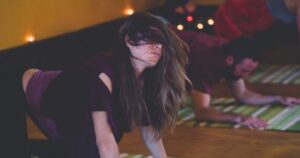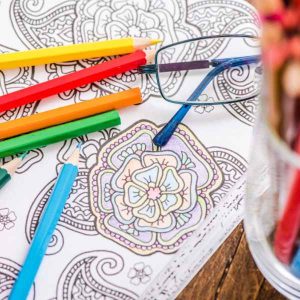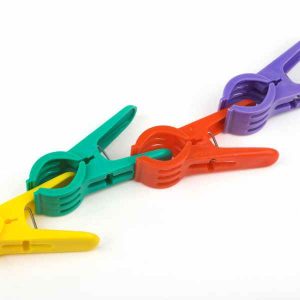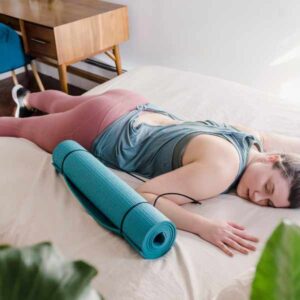Emotional First Aid
Emotional First-Aid refers to the immediate actions you can take to help regulate emotions when someone is experiencing intense feelings or shutting down.
That can happen for a bunch of reasons: a distressing, dangerous, or unpleasant environment or situation, or perhaps they're feeling tired, stressed, or overwhelmed. It can also be due to a sensitive nervous system, or too much sensory stimulation. Regardless of the cause, it's helpful to have a diverse set of tools in your emotional first aid kit.
Experimenting with different tools helps you discover what works best for you, ensuring you're prepared for any situation. Being adaptable and having a range of strategies at your disposal can significantly improve your ability to manage emotions effectively.
BREATHE
Guided breath practice can be a really resourceful form of emotional first aid to calm your mind & body.
BUT some people find regulating their breath to be stressful or distressing, which means it's not helpful at all! If you're one of those people, I invite you to explore some other categories of emotional first aid to see if there is something that works better for YOU.
These breath practices are designed to help you get in touch with YOUR breath & body. You may find they are too fast, or too slow. Perhaps you have a natural exhalation that is longer than your inhale. Maybe you find you inhale for longer than you exhale. Or you might be someone who has even breath in and then out.
There are 3 different tracks here to allow you to find the right rhythm for you. I suggest finding a breath that is comfortable for you however you are feeling today.
- Don't try or force yourself to breathe a lot slower than you already are.
- Don't try or force yourself to pick up where you left off last time.
- Your body will be different every time!
HYDRATE
Being well hydrated is critical for brain function and for regulating emotional state.
Dehydration increases your sensitivity to physical and emotional pain, and negatively impacts memory.
I have included drinking in Emotional First Aid, because it is such a simple action to take. When you feel like your resilience is low, or your mood is getting the better of you, a glass of water or two can very quickly redress that balance. At the very least it is a tangible action to help you connect back with your body.

Drink a glass of water, or up to a litre if you are feeling thirsty.
Mint, lime, or another garnish is lovely. If you have been sweating, adding some electrolytes (not a sugary drink), or try a coconut water.

Make a cup of tea, then set a timer for 5 minutes and sit somewhere quietly while you drink it.
If you're dehydrated, replace black tea with a non-caffeinated herbal tea. I love to make an infusion using rosemary, sage, or another fragrant herb from the garden or fridge.
I'm also a big fan of natural mood boosters like lemon balm and damiana tea.

Hydrate your skin with a spray of scented mist.
You can very easily make your own by adding some herbs or flowers to water in a mister. You could also use a drop of your favourite scented oil. For extra loveliness on a hot day - keep it in the fridge!
MOVE
There are two directions we can take for emotional first aid - a 'top down' approach, or 'bottom up'. Top Down refers to using our cognitive skills, that is using our mind and thoughts to calm our body. Bottom Up describes an approach that begins with tangible physical actions including movement and sensory experiences.
Bottom Up methods are the most powerful and easy to access in times of stress when our 'thinking mind' is already ramped up or shut down.

Choose some music you love and move to it.
There's no 'right' way to move, listening to the song and moving even just your big toe can be enough to shift those feels. I like to have a playlist of songs that range in accessiblity for me - some are full blown happy tunes, while others will give me the boost I need while still matching me where I am.

Lie on your back and walk your bottom towards the wall. Extend your legs up the wall. You can keep your legs bent, and your bottom as far away as you need to make this possible.
It is about having your feet and legs above your torso, not about having straight legs. This should be a pose that is relaxing. If the wall feels too intense, you could try resting your legs on a lounge or bed. Stay in this pose for 3 - 5 minutes.

Tapping into the activation of our bodies natural trauma release can help us to let go of stress, tension, and emotions. We can recalibrate our nervous system in times of heightened emotions, and also process longer held issues through shaking & bouncing.
Find a soft carpet, a mat, a mini tramp, or something that allows you to do a gentle cushioned bouncing movement. Not a full jump, just a bounce from your knees. Bounce for a few minutes while you imagine your problems bouncing down and out your feet.

Do an embodiment practice like the Movement Koan Method® video, an innovative fusion of joint-nourishing movement and body-based mindfulness.
- Ideal for daily joint maintenance, and an effective warm-up
- Long and short sequences
- Scaleable to any fitness level
- Brings ease to the body while stimulating the mind
- Improve neuroplasticity and body intelligence
- Develop muscular efficiency via somatic investigation

Do a Non-Linear Movement Method® Practice.
- Smooths out the nervous system.
- Processes & identifies emotion.
- Unites mind and body in intimacy with physical sensation.
- Awakens sexual energy & sensual sensation.
- Creates high bodily responsiveness.
- Releases trauma patterns into flow.
- Opens access to bodily wisdom.
Learn more about the method here.
LOOK
Exploring sensory approaches is a flexible way to find unique tools for YOUR emotional first aid kit.
Your visual sense can be used in endless ways to help you regulate & reset yourself emotionally. Here are just a few suggestions, but the world is your oyster and there are endless choices.
You could look at objects, landscapes, photos, paintings, books, art. Consider the mood evoked, the colour palette, your aesthetic. Perhaps you could collect some tangible items for your literal emotional first aid kit, like a postcard, some crayons, or a beautiful object.

Observe the natural world.
If you are able to go outside into a park or garden, then that's has multiple benefits. You can also simply observe a plant, flower, or other botanical.
Notice the texture, shape, colours, and details. Spend some time in active contemplation (or just point your face at some trees if that's where you're at!)

Observe art.
You could flip through a book, do some colouring, sit in front of a painting, go to a gallery, and more.
Notice different techniques, colours, contrasts, textures, details.
If you like this approach, you could add some pencils, a colouring book, a postcard, or a print to your literal emotional first aid kit (so it's easily on hand when you need it).

Play with cool visuals.
You could use a kaleidoscope, a zoetrope, a projector, print out some fractals, play with optical illusions and more. Hell, maybe just keep a romanesco broccoli in the fridge for emergencies!
This is a fun addition to your literal emotional first aid kit.

Sometimes instead of adding a sense, it's nice to notice what if feels like to rest that sense.
You could try removing your visual sense and see if that feels good. Like closing your eyes, using a blindfold, turning off the lights, or even wearing very dark glasses.
If any of these help you might add them to your literal emotional tool kit.

Sometimes instead of adding a sense, it's nice to notice what if feels like to rest that sense.
You could notice if you have been in harsh or bright light environments, and experiment with some softer lighting.
Try fairy lights, warm light globes, lamps, candles, and other soft lighting.

Sometimes instead of adding a sense, it's nice to notice what if feels like to rest that sense.
Spending time in a very familiar environment can help, or you could build your very own blanket fort or cubby house to retreat to.
Taking yourself away from the visual prompts of your regular life might give you a little space to rest & reset.
SMELL
Exploring sensory approaches is a flexible way to find unique tools for YOUR emotional first aid kit.
Your olfactory sense can be used in endless ways to help you regulate & reset yourself emotionally. Here are just a few suggestions, but get creative & consider what do YOU want to smell?
You might consider things that are typically suggested for emotional first aid like calming lavender, other herbs or botanicals, perfumes you love, familiar food smells, or you could add things that evoke specific & happy memories.

Try smelling some herbs that have calming properties.
That could include things like sage, rosemary, lemon balm, peppermint, and lavender. You could also just sniff a herbal tea bag, or add it to hot water, then inhale the scent. You can keep these in your literal emotional first aid kit for a good sniff when you're feeling low.

Find a smell that evokes a positive memory for you.
Like, coconut & lime together reminds me of summer & the beach. Or play-doh has this very specific nostalgic effect on me. Or the smell of my dogs ears or fur is super comforting.
Find a way to carry that smell with you - in a small kit, or your bag, or in your car. This can form part of your literal emotional first aid kit.

Find a strong smell that blows your hair back.
Sometimes a really strong sensory experience helps to move us from our emotions and back into our body.
It could be something like a perfume, a packet of gum or mints, tiger balm, citrus fruit, or a strong cup of coffee. Play with different scent profiles and notice which families of scents effect you in which way.

Notice whether there is a particular scent experience you'd like to evoke. This is a more complex scent profile, but could be a powerful way to shift your feels.
Maybe there is a particular meal that smells like comfort to you (that's laksa for me). It could be a cleaning product, type of crayon or oil paint, the exact linseed oil your grandparent used to oil their gardening tools.
Do some investigating & plan how to bring that scent into your emotional first aid tool box.

Sometimes instead of adding a sense, it's nice to notice what if feels like to rest that sense.
Try removing strong scents from your immediate environment, or simply take a break from adding scents.
If you need to protect yourself from strong smells, you can try a saline nasal spray, wearing a face mask, or even using nasal air filters.

Ask someone you love & feel safe with to wear a piece of your clothing overnight (they should definitely shower first!)
Their scent might be comforting for you, and this could also be a piece of clothing or an item that you add to your emotional first aid kit to wear or use.
LISTEN
Exploring sensory approaches is a flexible way to find unique tools for YOUR emotional first aid kit.
Your aural sense can be used in endless ways to help you regulate & reset yourself emotionally. Here are just a few suggestions, but get creative & consider what do YOU want to hear?
There are particular types of music that have a calming or regulating effect, but you could also have a fave punk classic or even the nostalgic sounds of a childhood cartoon might hit the emotional spot.

Nature sounds can be really relaxing-
There are countless hours of forest sounds, birds, bamboo, ocean, the Australian bush, and more (just search in your favourite music app).
You could try the sounds of a creek, river, or the ocean. Rain or a storm.
Or, you know, go outside and just listen.

White, brown, or pink noise might feel soothing.
These different flavours of sound include random sounds in specific bands of frequency. Some people find the slight distraction or background noise to be relaxing & comforting.
There's a bazillion playlists online for each of these frequencies.

Make your own first aid playlist.
Some people find heavy metal relaxing, others love classical, and still others find soothing in all the genres in all the lands.
When you make this playlist, ask yourself; which songs bring me into a state of calm & safety? That's different to immersing in your feelings. It's about eliciting an experience of being okay.





